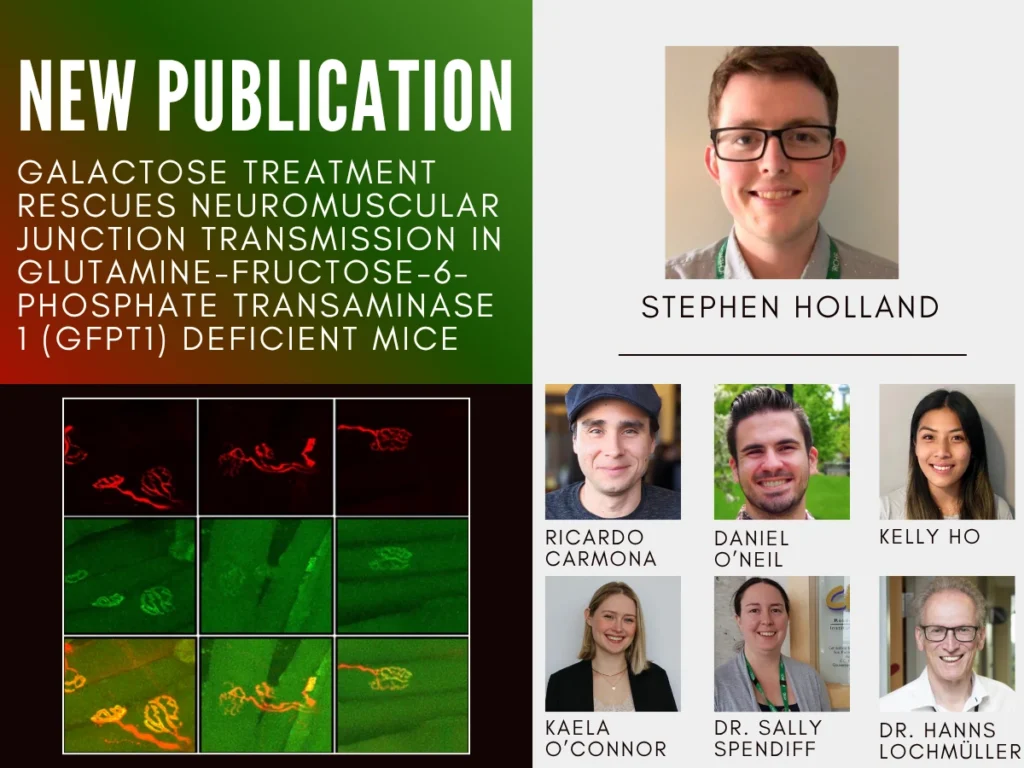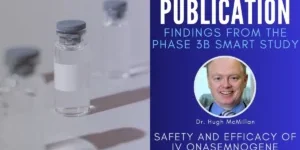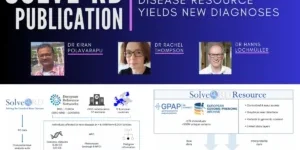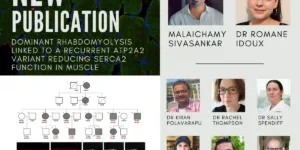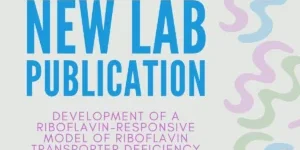New Publication: Galactose treatment rescues neuromuscular junction transmission in glutamine-fructose-6-phosphate transaminase 1 (Gfpt1) deficient mice
Congenital Myasthenic Syndromes (CMS) are a group of rare inherited neuromuscular disorders caused by genetic defects at the neuromuscular junction (NMJ). Patients with CMS experience fatigable muscle weakness due to mutations affecting NMJ development, maintenance, and function. More than 35 genes have been implicated in CMS, revealing disease mechanisms across the presynaptic nerve terminal, synaptic cleft, and postsynaptic skeletal muscle.
Although there are currently no approved treatments for CMS, some patients benefit from acetylcholinesterase inhibitors or β2 adrenergic receptor agonists. However, these therapies can cause side effects and lose effectiveness over time, underscoring the need for alternative treatment options for CMS. Given the genetic heterogeneity of the disease, the Lochmüller lab is exploring a subtype-specific approach to developing new therapeutic strategies.
About the Study
In the lab’s new publication, Galactose treatment rescues neuromuscular junction transmission in glutamine-fructose-6-phosphate transaminase 1 (Gfpt1) deficient mice, published in Human Molecular Genetics, first author Stephen Holland and colleagues investigated a potential new treatment for GFPT1-CMS, a subtype caused by mutations in the glutamine–fructose-6-phosphate transaminase 1 (GFPT1) gene. GFPT1 encodes the rate-limiting enzyme of the hexosamine biosynthetic pathway (HBP), which produces UDP-GlcNAc, a key precursor for protein glycosylation and O-GlcNAcylation. This gene was first identified as a CMS-causing gene by the Lochmüller lab with collaborators at Federal Institute of Technology Zurich in 2011. Previous work from the team demonstrated that loss of Gfpt1 impairs protein glycosylation and disrupts neurotransmission in mouse models. Galactose supplementation is an effective treatment in congenital disorders of glycosylation (CDG), caused by mutations in other glycosylation-related genes. Building on this, Stephen and the team explored whether galactose supplementation could restore glycosylation through the Leloir pathway, by elevating UDP-GlcNAc levels and potentially bypassing the defective HBP.
Outcome
Initial in vivo results showed that galactose treatment of Gfpt1-deficient myoblasts activated the Leloir pathway and rescued protein O-GlcNAcylation. The results in Gfpt1 knockout mice were striking: galactose supplementation partially rescued muscle grip strength fatigability, increased the activity of mice, and improved muscle fiber morphology. Treated mice also showed improved NMJ morphology, including increased axonal diameter, acetylcholine receptor (AChR) area, and endplate area. Galactose treatment also improved the area of contact between the pre and post-synaptic apparatus of the NMJ, which was disrupted in Gfpt1 knockout mice. Finally, NMJs of treated mice showed restored protein O-GlcNAcylation, demonstrating that galactose treatment rescues skeletal muscle glycosylation in Gfpt1 knockout mice
These compelling results provide the first preclinical evidence that galactose supplementation could represent a targeted therapeutic strategy for patients with GFPT1-CMS through the improvement of glycosylation status and the restoration of NMJ function.
Reference
Holland SH, Carmona-Martinez R, O’Neil D, Ho K, O’Connor K, Azuma Y, Roos A, Spendiff S, Lochmüller H. Galactose treatment rescues neuromuscular junction transmission in glutamine-fructose-6-phosphate transaminase 1 (Gfpt1) deficient mice. Hum Mol Genet. 2025 Oct 14;34(21):1765-1779. doi: 10.1093/hmg/ddaf140.
Click here to access the manuscript

